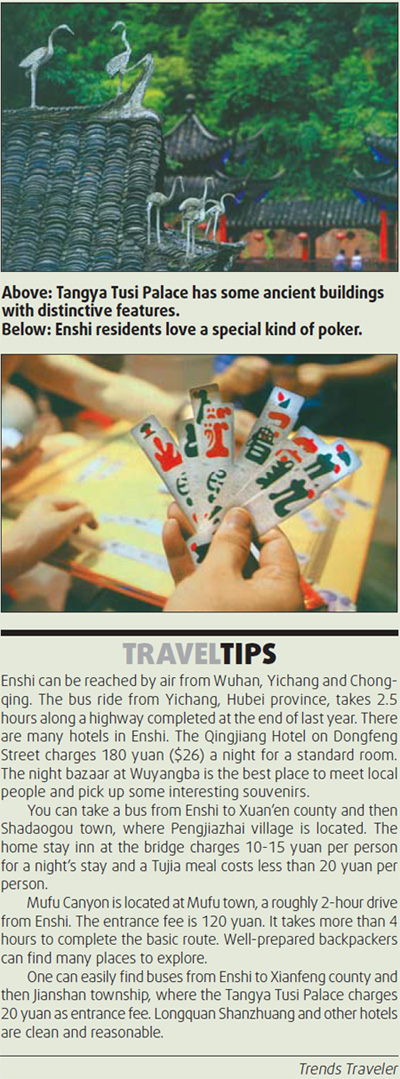Back to a bygone era

Mufu Canyon
Some 60 km from Enshi is Mufu Canyon, that plunges more than 1,500 m. Our bus follows a road winding down into the valley amid a thickening fog. Suddenly, a giant rocky cliff that seems to pop out of the sky appears, as if about to crash into our tiny bus.
The driver heads toward the cliff without slowing down. I heave a sigh of relief when I realize we are squeezing through a narrow crevice into the canyon.
It is even more precarious inside the valley. We walk gingerly on a planked road built along the waist of the cliff. I feel like a helpless leaf about to fall into the dazzling abyss. Looking up, I realize the vertical precipice offers no place for me to grab should I trip and fall.
Finally, we reach the Talang ("Standing on the Waves") Pavilion, perched on one of numerous peaks. The planked road looks like a thin black line. Mountains dot the horizon, with villages scattered among them.
There are many smaller valleys inside the canyon. Having no roads, they are ideal for the audacious explorer.
Tusi's palace
Located an hour's drive from Enshi, the ruins of Tangya Tusi Palace rest on the banks of Tangya River. I get off the bus and follow the river. Half an hour later, I find a stone stele carved with the name of the palace. A piece of cardboard dangling on a tree shows the keeper's phone number.
I call. Soon, a thin old man with a long silvery beard walks slowly down the mountain path, wearing a pointed straw hat and leaning on a bamboo stick. Chen Zhaonan, 79, has been guarding the ruins since 1981.
Tusi, or chieftain of the Tujia people, used to rule the area like an emperor. The rule of Tan Ding, a 12th generation Tusi who fought bravely for Emperor Xizong of the Ming Dynasty (1368-1644), marked the peak of Tusi rule in the area.
The roads here are broad and smooth, with stone slabs. Chen says there were once 48 streets and 48 wells here, serving some 30,000 people in 4,800 families.
But all that is left of it now is a village thriving on rice paddies, tea farms and bamboo groves.
Hitting the stone slabs with his stick, Chen says the roads used to be more than 7 m wide. But villagers have been removing the stones to build their own houses.
Most people who still live here are descendants of those who lived under the Tusi. Chen claims his family was related to the Tusi chieftain. Eighteen generations ago, his ancestor married a daughter of the chieftain.
"This used to be our family's residence," he says, pointing at a stone threshold half buried in the fields.
Climbing deeper into the mountains, I find Tan Guo'an, a descendant of the ancient Tusi. Most members of the Tan family have moved to Guizhou province; only he stayed behind, to guard the tomb of Tan Ding and his wife.
Night descends quickly in the mountains. Our minivan speeds through the forest of giant firs, as I leave behind the once glorious Tusi kingdom.
 0
0 






